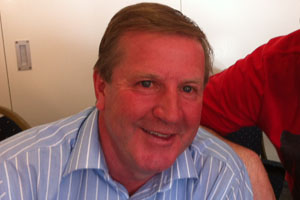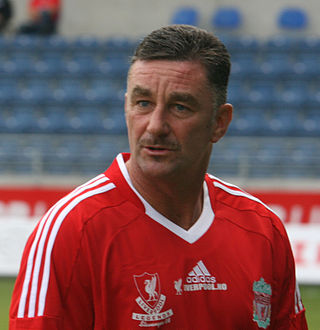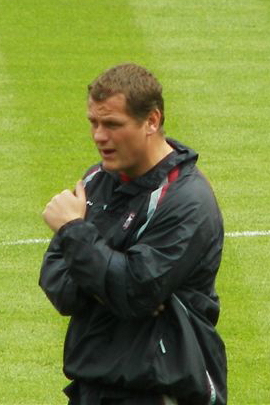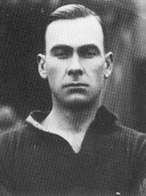Related Research Articles
Albert Stubbins was an English footballer. He played in the position of centre forward, although his career was limited by the onset of World War II. While playing for Liverpool, he won the League Championship in 1947. He was later included on the front cover of The Beatles' Sgt. Pepper's Lonely Hearts Club Band album.

Jan Mølby is a Danish former professional footballer and manager. As a player, he was a midfielder from 1982 to 1998. After starting his career with Kolding, he moved on to Ajax before spending twelve years playing in England with Liverpool. He was capped 33 times by Denmark, scoring twice.

Emlyn Walter Hughes was an English footballer. He started his career at Blackpool in 1964 before moving to Liverpool in 1967. He made 665 appearances for Liverpool and captained the side to three league titles and an FA Cup victory in the 1970s. Added to these domestic honours were two European Cups, including Liverpool's first in 1977; and two UEFA Cup titles. Hughes won the Football Writers' Player of the Year in 1977. Hughes completed a full set of English football domestic honours by winning the League Cup with Wolverhampton Wanderers in 1980. In addition to Wolves, he later played for Rotherham United, Hull City, Mansfield Town and Swansea City. Hughes earned 62 caps for the England national team, which he also captained.

Roger Hunt was an English professional footballer who played as a forward.

Robert Paisley OBE was an English professional football manager and player who played as a wing-half. He spent almost 50 years with Liverpool and is regarded, due to his achievements with the club, as one of the greatest British managers of all time. Reluctantly taking the job in 1974, he built on the foundations laid by his predecessor Bill Shankly. Paisley is the first of three managers to have won the European Cup three times. He is also one of five managers to have won the English top-flight championship as both a player and manager at the same club.

Ian Robert Callaghan MBE is an English retired professional footballer who played as a midfielder. He holds the record for most appearances for Liverpool. He was appointed a Member of the Order of the British Empire (MBE) in the 1975 New Year Honours.

Ronald Andrew Whelan is an Irish former professional footballer player who played as a midfielder and sometimes as a defender. He played an integral role in the dominant Liverpool side that won a wealth of titles in the 1980s. He was at the club from 1979 until 1994, scoring a number of vital goals. In 100 Players Who Shook The Kop, a poll of 110,000 Liverpool fans conducted by Liverpool's official website, Whelan came in 30th.

David Fairclough is an English retired footballer, most famous for playing for Liverpool as a striker during the 1970s and 1980s.

Chris Lawler is a former footballer who enjoyed much of Liverpool's success of the mid 1960s to early 1970s.

John William Aldridge is a former football player and manager. He was a prolific, record-breaking striker best known for his time with English club Liverpool in the late 1980s. His tally of 330 Football League goals is the sixth-highest in the history of English football.
Alan A'Court was an English footballer who mostly played for Liverpool. He gained five caps for England and represented the nation at the 1958 FIFA World Cup.

James Magilton is a Northern Irish football manager and former professional player.

William Beveridge Liddell was a Scottish footballer, who played his entire professional career with Liverpool. He signed with the club as a teenager in 1938 and retired in 1961, having scored 228 goals in 534 appearances. He was Liverpool's leading goalscorer in the league in eight out of nine seasons from 1949–50 to 1957–58, and surpassed Elisha Scott's club record for most league appearances in 1957.

Gordon Hodgson was a professional sportsman, born in Transvaal Colony, who is best known as a striker for Liverpool and as a fast bowler for Lancashire. He won two international caps for South Africa and three for England.
Andrew McGuigan was a Scottish professional footballer, described as "speedy and tricky".

William Lacey was an Irish footballer who played for, among others, Shelbourne, Liverpool, Everton and Linfield. Lacey was a dual international and also played for both Ireland teams – the IFA XI and the FAI XI.
John Miller was a Scottish footballer who played in the Football League for Bolton Wanderers, Derby County and The Wednesday.
Ronald Guinness Orr Gunion, known as Ronald Orr was a Scottish footballer, who played for Newcastle United and Liverpool amongst others in the early 20th century. He played twice for Scotland in 1902 and 1904, scoring one goal.

Fred Geary was an English professional footballer who played at centre forward for Everton in the 1890s, and made two appearances for England, scoring a hat-trick on his debut.
John Lindsay was a Scottish footballer who played as a left-half and an outside-left, most notably for Liverpool.
References
- ↑ Report on Northern Ireland's oldest man
- ↑ "Liverpool career stats for Billy Millar - LFChistory - Stats galore for Liverpool FC!". www.lfchistory.net. Retrieved 2 June 2023.
